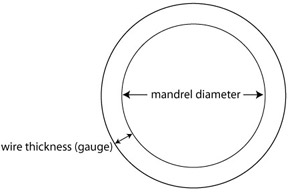If you have made a linked chain you like, and you want to make a smaller or larger version of it, you need to find the aspect ratio of the links you used. The aspect ratio of any ring is the relationship between the diameter of the mandrel you wound the wire on and the thickness of the wire.
| Aspect Ratio = |
mandrel diameter
wire thickness |
scale – metric is preferred. Use the “Wire Gauge Comparison Chart” to find the metric equivalents of the diameters you know.
|
 |
EXAMPLE:
You like the Byzantine chain that you made with 18 gauge wire wrapped around a 9/64” mandrel. You look in the “Wire Gauge Comparison Chart” and find the following values for the diameters:
9/64” = 3.57 mm
18 ga = 1.02 mm
|
| Aspect Ratio = |
mandrel diameter
wire thickness |
= |
3.57 mm
1.02 mm |
= |
3.5 |
|
| You can use the aspect ratio to discover the mandrel size needed to make this same chain in a different gauge of wire. For example, to make your Byzantine chain in 22 gauge wire, first, find the metric value of the new wire gauge, then multiply the aspect ratio by that metric value of the new wire gauge to get the new mandrel size: |
| 22 ga = 0.632 mm |
new mandrel = (aspect ratio) x (new wire) |
| new mandrel = 3.5 x 0.632 mm = 2.212 mm |
|
| Go back to the “Wire Gauge Comparison Chart” and look for the closest value to 2.212mm. Now look for the size of a mandrel you have that is closest to that value. In the chart, you will see that 3/32” = 2.38mm, which is pretty close to the desired 2.212mm. 3/32” is also a size that is available in the inch/fraction transfer punch set (used for mandrels). A 2.5mm mandrel from a metric transfer punch set would probably be too big, and a 2mm mandrel would probably be too small. It is usually better to go for a mandrel that is a bit bigger than your calculated need, rather than smaller. Still, you should always make an 8-10cm piece of test chain out of brass or copper wire to be sure that your links end up producing a pleasing result. |

